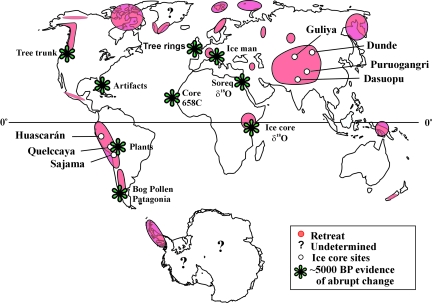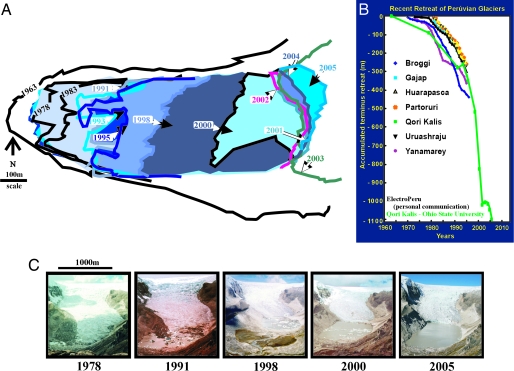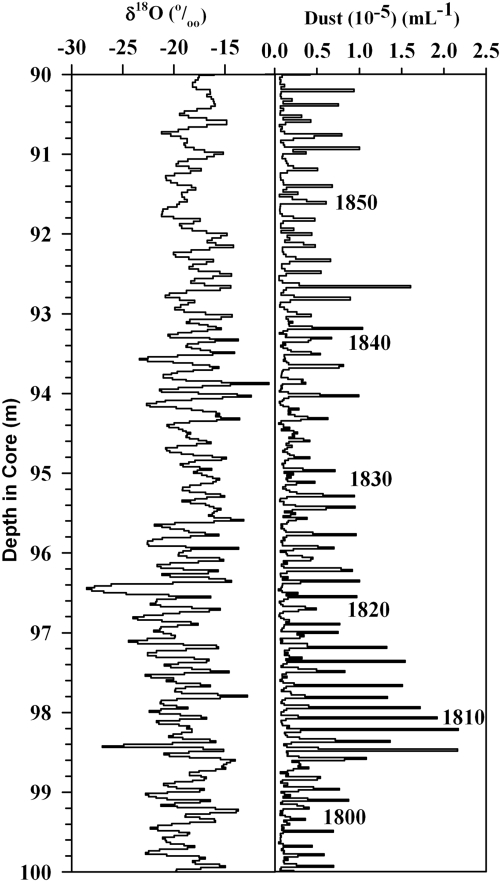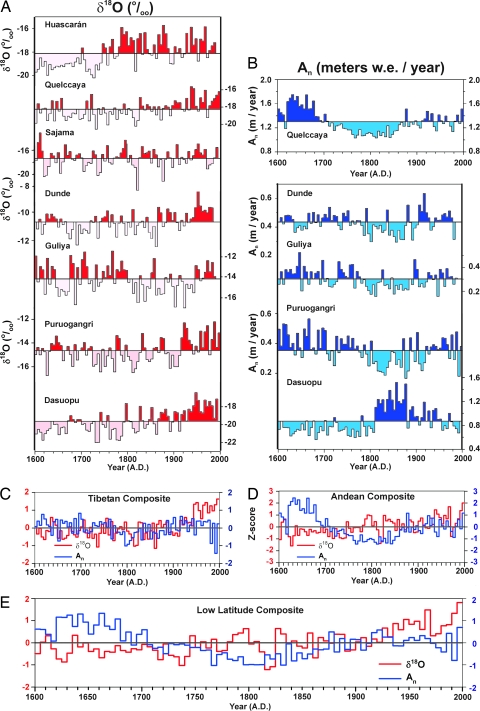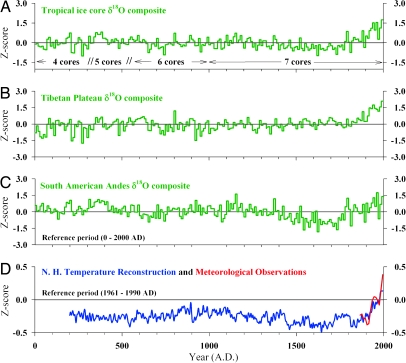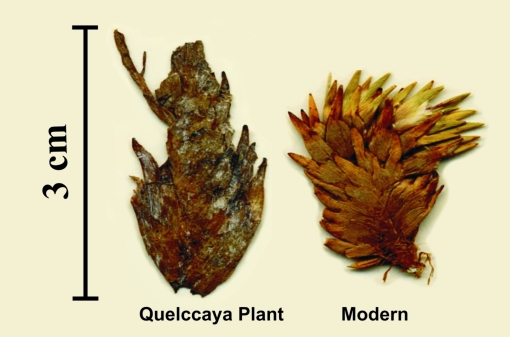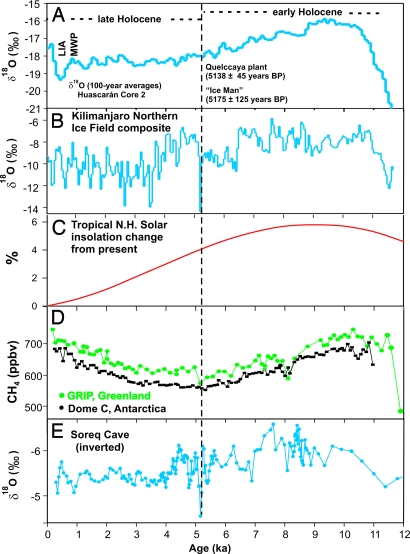Abstract
Three lines of evidence for abrupt tropical climate change, both past and present, are presented. First, annually and decadally averaged δ18O and net mass-balance histories for the last 400 and 2,000 yr, respectively, demonstrate that the current warming at high elevations in the mid- to low latitudes is unprecedented for at least the last 2 millennia. Second, the continuing retreat of most mid- to low-latitude glaciers, many having persisted for thousands of years, signals a recent and abrupt change in the Earth’s climate system. Finally, rooted, soft-bodied wetland plants, now exposed along the margins as the Quelccaya ice cap (Peru) retreats, have been radiocarbon dated and, when coupled with other widespread proxy evidence, provide strong evidence for an abrupt mid-Holocene climate event that marked the transition from early Holocene (pre-5,000-yr-B.P.) conditions to cooler, late Holocene (post-5,000-yr-B.P.) conditions. This abrupt event, ≈5,200 yr ago, was widespread and spatially coherent through much of the tropics and was coincident with structural changes in several civilizations. These three lines of evidence argue that the present warming and associated glacier retreat are unprecedented in some areas for at least 5,200 yr. The ongoing global-scale, rapid retreat of mountain glaciers is not only contributing to global sea-level rise but also threatening freshwater supplies in many of the world’s most populous regions.
Keywords: icecore, isotopes, paleoclimate, precipitation, Holocene
Today most glaciers outside the polar regions are retreating at accelerating rates (1, 2). This retreat is particularly evident in the high Andes of Peru, which contain 70% of the Earth’s tropical glaciers. The first long tropical ice cores were retrieved in 1983 from the Quelccaya ice cap (Fig. 1), the Earth’s largest tropical ice cap, which is 5,670 m above sea level in the southeastern Andes of Peru (3). Because of its dome shape, Quelccaya is very sensitive to the current increase in the elevation of the 0°C isotherm (4), and it loses more mass per unit rise in the equilibrium line than steeper alpine glaciers (5). This sensitivity makes Quelccaya an obvious choice for monitoring changes in both ice mass and ice-cover extent.
Fig. 1.
The locations of ice cores and evidence for abrupt climate change ≈5,000 yr ago discussed in the text are shown along with areas of large-scale ice retreat.
The retreat of Quelccaya’s largest outlet glacier, Qori Kalis, has been evaluated by terrestrial photogrammetry since 1978 (6). These observations, along with a map produced from aerial photographs taken in 1963, allow changes in ice area and volume over the last 42 yr to be assessed. A sequence of maps documents the rapid and accelerating retreat of the glacier front (Fig. 2A). In the last 14 yr (1991-2005), Qori Kalis has been retreating ≈10 times faster (≈60 m·yr−1) than during the initial measurement period of 15 yr from 1963 to 1978 (≈6 m·yr−1). A small proglacial lake that first appeared in 1991 and covered ≈6 hectares has grown contemporaneously with the retreat of the ice front and now covers ≈34 hectares (Fig. 2C). On the basis of sonar observations in 2004, the lake is up to ≈60 m deep. The accelerating rate of retreat of the Qori Kalis terminus is consistent with that observed for six other glaciers in the Cordillera Blanca (Fig. 2B) that have been monitored by the power company ElectroPeru (7). This recent and rapid loss of ice on Quelccaya is characteristic of most low- and mid-latitude ice fields and is best typified by Kilimanjaro’s three remaining ice fields, which have persisted for at least 11,000 yr and have lost 82% of their areal extent since 1912 (8). Aerial photographs taken in January 2006 confirm the continued reduction of ice cover.
Fig. 2.
Glacier retreat as documented in the Peruvian Andes. (A) Retreat of Qori Kalis from 1963 to 2005. (B) Retreat records for Qori Kalis and six other Andean glaciers. (C) The photos document the expansion of the proglacial lake from 1991 to 2005 as Qori Kalis retreated.
The chemical and physical properties preserved within glaciers and ice caps also record climatic and environmental changes that provide a longer-term context for 20th-century changes. When the first two Quelccaya cores were drilled in 1983, it was impossible to return frozen samples from the field; thus, the cores were cut into ≈6,000 samples that were melted, bottled, and returned to the Byrd Polar Research Center at Ohio State University, where their dust content and liquid conductivity were measured. The δ18O measurements were made at the University of Copenhagen and the University of Washington (3). Stable isotopic ratios (δ18O, δ2H) preserved in mid- to low-latitude glaciers provide a valuable tool for paleoclimate reconstruction and, when they are combined with other ice-core properties such as dust concentrations, aerosol chemistry, and accumulation rates, a richer picture of past regional climate conditions emerges. In 2003, a new ice core was drilled to bedrock on the summit of Quelccaya, but this time it was returned frozen to Byrd Polar Research Center, where concentrations of dust and various chemical species and the stable isotopic ratios were measured.
A.D. 1600 to the Present
Fig. 3 illustrates the seasonally varying constituents used to construct a highly accurate time scale for the 2003 Quelccaya core. Comparison of the annually averaged δ18O records (A.D. 1540–1983) from the 1983 core (blue) and 2003 core (red) confirms that the time scales are virtually identical (Fig. 4). This agreement is significant for two reasons. First, it finally confirms the time scale for the 1983 Quelccaya core. Second, it demonstrates that the δ18O record has been excellently preserved within the ice cap even though its surface has been subjected to warming conditions for the intervening 20 yr. Thus, the Quelccaya δ18O record, if correctly interpreted, provides an ≈1,500-yr context for the recent period of accelerating glacier retreat.
Fig. 3.
The excellently preserved seasonal variations in δ18O and insoluble dust, illustrated for the core section from 90 to 100 m depth, were used to date the 2003 Quelccaya ice core and reconstruct the annual accumulation history.
Fig. 4.
The annual average δ18O values for the 1983 Quelccaya core, measured on bottled water from samples cut and melted in the field, are compared with those for the 2003 Quelccaya core, which were returned frozen to Ohio State University, allowing freshly cut samples to be analyzed. Even after 20 yr of surface melting, the reproducibility over the last 460 yr is excellent. For data, see Data Set 1, which is published as supporting information on the PNAS web site.
The δ18O–air temperature (Ta) relationship is fairly well established for Antarctica and Greenland (9) but remains more controversial for high mountain regions in mid- to low latitudes. Empirical investigations are limited. It was found in a study of the δ18O–Ta relationship for discrete precipitation events at three sites on the Tibetan Plateau (TP) that although dynamical processes dominate δ18O on short time scales, air temperature is the primary control on longer-term (more than annual) δ18O variations at individual sites (10). In the Andes, the controls on δ18O in recent snowfall have been investigated by using observations (11) and models (12, 13). Strong linkages have been demonstrated (14) between sea-surface temperatures across the equatorial Pacific Ocean and δ18O in ice cores from the tropical Andes and the Himalaya (Dasuopu glacier). More recently, it has been suggested (15) that δ18O ultimately records changes in the atmospheric circulation that integrate all aspects of transport from source to sink. Although not fully resolved, the weight of available empirical evidence, including that presented in Fig. 5, strongly suggests that on longer time scales, δ18O variations in low-latitude mountain precipitation reflect variations in air temperature more strongly than variations in precipitation (6, 10, 11, 16, 17).
Fig. 5.
Climate reconstructions over the last four centuries. The 5-yr averages of δ18O (A) and accumulation (B) for seven and five low-latitude ice cores, respectively, were reconstructed back to A.D. 1600. Accumulation is given in meters of water equivalent (w.e.) per yr. Annual layers (and hence An) were not reconstructed for Huascarán and Sajama as discussed in the text. Composite δ18O and An records for the TP (C) and Andean (D) cores were combined to produce low-latitude composite δ18O and An histories (E) for the last 400 yr. The composite records are shown as Z-scores. Data are provided in Data Set 2, which is published as supporting information on the PNAS web site.
Over the past two decades, the Byrd Polar Research Center ice-core group has recovered cores from ice fields across Tibet and in the Andes (see Fig. 1 for locations). Various aspects of these records have been published, but they have not been integrated and interpreted collectively. Here the 5-yr averages of δ18O and net mass accumulation (An) from these cores are compared for the last 400 yr (Fig. 5), and the decadally averaged δ18O histories are compared for the last 2,000 yr (Fig. 6). Combining these records provides a more comprehensive picture of tropical climate variability.
Fig. 6.
Climate reconstructions over the last two centuries. (A) Decadal averages of δ18O from low-latitude, high-elevation ice fields are combined for the last 2,000 yr. The number of cores contributing to various parts of the 2,000-yr record is shown. (B and C) Also shown are the composites for four TP (B) and three Andean (C) cores. (D) The ice core records are compared with the Northern Hemisphere meteorological observations (red) back to A.D. 1860 (50) and a multiproxy history (blue) back to A.D. ≈200 (51). Data are provided in Data Set 3, which is published as supporting information on the PNAS web site.
The 5-yr averages of δ18O for three Andean and four TP records are shown in Fig. 5A. Five of these cores, Dunde (18), Guliya (19), Puruogangri (20), Dasuopu (21), and Quelccaya (3), contain distinct annual layers for the last 400 yr. Fig. 5B shows the 5-yr average An in meters of water equivalent for the last 400 yr for five of these seven cores. Because the rapidly thinning layers on Sajama (22) and Huascarán (23) required use of a flow model, constrained by time-stratigraphic horizons, to construct their time scales, An records could not be constructed. Thus, Quelccaya provides the only reliable ice-core-derived An history for the past 400 yr in the Andes. A recently reconstructed 400-yr high-resolution pollen history from Sajama (24) indicates wetter conditions from A.D. 1500 to 1700 and drier conditions from A.D. 1700 to 1880, generally consistent with the An record from Quelccaya to the north (Fig. 5B).
Meteorological data show that annual precipitation decreases from east to west and from south to north across the TP, whereas in the South American Andes precipitation decreases from north to south (25). The ice fields located in more arid regions of the TP (Dunde, Guliya, Puruogangri), have rather similar An histories (Fig. 5B) with higher values in the 17th and 18th centuries, consistently lower values in the 19th century, and a general increase over the 20th century. In contrast, the An history on Dasuopu in the Himalayas shows a different pattern, with consistently high An over most of the 19th century. Although the 400-yr An history for the Himalayas (e.g., Dasuopu) is markedly different from that over the TP to the north, their δ18O histories, or proxy temperature records (26), are remarkably similar at lower frequencies. Moreover, the δ18O trend over the TP is similar to that in the tropical Andes (Fig. 5), although the TP warming starts somewhat earlier. During the 17th century conditions were warmer over Guliya and Puruogangri than over Dunde and Dasuopu, but all of the time series indicate persistent and gradual warming (18O enrichment) from the 18th through the early 20th century, with an accelerating warming over the second half of the 20th century. Note that this recent isotopic enrichment is consistent among the TP sites and independent of An (Fig. 5). The latter is confirmed by a lack of any statistically significant correlation between the 5-yr averages of δ18O and An for the five sites with An records (R values: Guliya, +0.0001; Puruogangri, +0.005; Dunde, −0.019; Dasuopu, +0.129; Quelccaya, −0.069).
In the tropical Andes 18O enrichment begins earlier, around A.D. 1750, at the Huascarán site, which is closer to the equator, whereas 18O enrichment begins around A.D. 1830 on Quelccaya further to the south. Interestingly, the δ18O history from Sajama, the southernmost core site, located in a very dry region, shows little trend over the 400-yr period. Despite the local and regional variability captured by these 400-yr δ18O records, with the exception of Sajama, they all record a consistent 20th-century 18O enrichment, the dominant climate signal over both the Andes and the TP (Fig. 5 C and D, respectively). The tropical δ18O composite (Fig. 5E), created by combining the TP and Andean δ18O records, clearly records the isotopic depletion (cooling) during the latter part of the so-called Little Ice Age (LIA) from A.D. ≈1600 to 1870, with the greatest depletion from A.D. 1810 to 1820, reflecting a strong cooling that followed the large volcanic eruptions of “unknown” in 1809 (27) and Tambora in 1815.
The Last Two Millennia
To capture larger temporal scale changes, regional composites for the TP (Fig. 6B) and the Andes (Fig. 6C) were constructed by using the decadal averages of δ18O over the last 2,000 yr. Because 70–80% of the snowfall over both the TP and the Andes arrives during their respective summers (Northern Hemisphere summer for the TP and Northern Hemisphere winter for the Andes), combining the seven δ18O records provides an annually representative proxy (δ18O) temperature history for high-elevation ice fields in the mid- to low latitudes, as shown in Fig. 6A. This tropical composite is based on seven cores for the last 1,000 yr, six cores for the last 1,550 yr, and four cores for the last 2,000 yr. The Andean composite, and thus the Tropical composite, shows modest 18O enrichment from A.D. 300 to 500 and A.D. 1100 to 1300 (the so-called Medieval Warm Period) and depletion from A.D. 1400 to 1900 (LIA). Neither the Medieval Warm Period nor the LIA is discernable in the TP composite. However, all three composites (Fig. 6 A–C) clearly reveal that a large and unusual warming (18O enrichment) is underway at high elevations in the tropics. Although the factors driving the current 18O enrichment (warming) may be debated, the tropical ice core δ18O composite (Fig. 6A) confirms that it is unusual from a 2,000-yr perspective. Regardless of whether δ18O is interpreted as a function of temperature, precipitation, and/or atmospheric circulation, the important message clearly preserved in these high-elevation ice fields is that the large-scale dynamics of the tropical climate system have changed.
An important feature of the tropical climate regime is that horizontal temperature variations are small above a relatively shallow atmospheric layer near the Earth’s surface. This condition results from the lack of a strong Coriolis effect to balance pressure differences resulting from temperature variations, and thus the tropical atmospheric mass is redistributed so as to nearly eliminate horizontal temperature gradients (28, 29). Of the meteorological variables controlling glacier mass balance (temperature, precipitation, cloudiness, humidity, etc.), only temperature exhibits large-scale spatial homogeneity, suggesting that it is the primary variable driving the retreat of most tropical ice fields. Further support comes from the general uniformity of the tropical δ18O composites (Fig. 6 A–C) and the dominance of 20th-century 18O enrichment (warming) that is concomitant with the rapid melting. The evidence presented here indicates that rising air temperature (not reduced precipitation) is the primary driver of glacier retreat in the tropics and subtropics. This interpretation is supported by recent results (30) indicating that the observed tropical warming is consistent with the satellite-derived temperatures for both the surface and the middle/upper troposphere. Another study (31) has reported the amplification of surface-temperature trends and variability in the tropical atmosphere.
The Holocene
The third line of evidence for abrupt tropical climate change comes from a rooted, soft-bodied plant deposit discovered after it was exposed along the west-central margin of the rapidly retreating Quelccaya ice cap. The plant was identified as the wetland plant Distichia muscoides (Juncaceae), a dioecious mat- or cushion-forming plant (Fig. 7) that is well adapted to harsh diurnal freezing and thawing and often reaches the altitudinal vegetation limit, which is ≈5,100 m above sea level around the Quelccaya ice cap. The average of eight accelerator mass spectrometry 14C dates from two different laboratories places the calendar age of this plant deposit at 5,138 (±45) yr B.P. (Table 1). The recently exposed plant deposit provides strong evidence that temperatures were warmer in this region before 5.1 thousand years (ka) B.P. and that the current retreat of Quelccaya is unprecedented for the last 5 millennia. The δ18O history (Fig. 8A) from the ice core drilled to bedrock on Huascarán (6,048 m above sea level) in northern Peru supports this scenario. Like Quelccaya, the Huascarán δ18O record shows the 20th-century warming, the LIA, and the Medieval Warm Period (Fig. 8A). However, the Huascarán record is much longer, extending back into the last glacial stage and indicating that conditions were warmer (18O-enriched) from ≈11 to 6 ka (the early Holocene) than in the late Holocene (23). In fact, the Huascarán δ18O record suggests that temperatures in the tropical Pacific were ≈1.5 to 2.0°C warmer between ≈11 and 8 ka (14, 23), contemporaneous with the warmest period of the Holocene in this region. Elevated dust concentrations during the early Holocene (data not shown; see ref. 23) suggest that conditions were also somewhat drier. The impact of this change on the tropical hydrologic cycle is also reflected in the isotopic record of calcite from Lake Junin, Peru (32), which closely resembles the Huascarán Holocene δ18O curve. The Huascarán record (Fig. 8A) illustrates the full range of climate variability between the last glacial stage and the early Holocene, when D. muscoides was growing along the recently deglaciated margin of Quelccaya.
Fig. 7.
The plant Distichia muscoides (5,138 ± 45 yr B.P.) collected at the retreating margin of the Quelccaya ice cap in August of 2002 is compared with the modern plant (see Table 1 for dates on this and other plants).
Table 1.
Results of eight accelerator mass spectrometry 14C dates on D. muscoides indicate that the specimens collected at Quelccaya date to 5,138 ± 45 yr B.P.
| Sample no. | 14C age, yr | Calibrated age, yr (before A.D. 1950) | Relative area under probability distribution | Year collected |
|---|---|---|---|---|
| Lawrence Livermore National Laboratory | ||||
| Sample 1 | 4,470 ± 60 | 5,284–5,161 (1σ) | 0.534 | 2002 |
| Run 1 | 5,302–4,961 (2σ) | 0.926 | ||
| Sample 1 | 4,525 ± 40 | 5,186–5,121 (1σ) | 0.413 | 2002 |
| Run 2 | 5,311–5,047 (2σ) | 1.000 | ||
| Sample 2 | 4,530 ± 45 | 5,186–5,120 (1σ) | 0.396 | 2002 |
| Run 1 | 5,317–5,040 (2σ) | 0.993 | ||
| Sample 2 | 4,465 ± 40 | 5,278–5,171 (1σ) | 0.580 | 2002 |
| Run 2 | 5,295–4,967 (2σ) | 0.984 | ||
| NOSAMS Facility at Woods Hole Oceanographic Institution | ||||
| Sample 1 | 4,530 ± 45 | 5,186–5,120 (1σ) | 0.396 | 2002 |
| 5,317–5,040 (2σ) | 0.993 | |||
| Sample 2 | 4,510 ± 40 | 5,188–5,119 (1σ) | 0.404 | 2002 |
| 5,307–5,040 (2σ) | 0.988 | |||
| Sample 3 | 4,440 ± 45 | 4,979–4,866 (1σ) | 0.829 | 2005 |
| 5,066–4,845 (2σ) | 0.907 | |||
| Sample 4 | 4,570 ± 45 | 5,188–5,055 (1σ) | 0.714 | 2005 |
| 5,314–5,034 (2σ) | 0.959 | |||
NOSAMS, National Ocean Sciences Accelerator Mass Spectrometry.
Fig. 8.
Holocene tropical climate variability. Holocene δ18O ice-core records recovered from Huascarán (23) (A) and Kilimanjaro (8) (B) along with tropical Northern Hemisphere (N.H.) insolation change from the present (33) (C), methane records from Greenland (37) and Antarctica (38) (D), and the Soreq Cave δ18O record (43) (E). GRIP, Greenland Ice Core Project; ppbv, parts per billion by volume.
The burial of such soft-bodied plants by the ice ≈5.1 ka is consistent with the onset of an abrupt cool, wet period that led to the expansion of the Quelccaya ice cap. Thereafter, the δ18O record from Huascarán indicates a sustained cooling (18O depletion) that culminated with the LIA (the coldest interval in the Huascarán Holocene record). Reduced dust concentrations (data not shown; see ref. 22) also suggest more humid conditions during this cooler period, the late Holocene, that was abruptly terminated by 20th-century warming (Fig. 8A).
A survey of other paleoclimate records from both low and high latitudes, including ice cores from the tropics, supports the view that the early to mid-Holocene was warmer than the latter half of the Holocene. The δ18O and aerosol (data not shown; see ref. 8) records from Kilimanjaro in equatorial Africa (Fig. 8B) indicate an early Holocene warm period with a variable and much wetter climate than that during the cooler and drier late Holocene (8). The general shape of the δ18O profile from both Huascarán and Kilimanjaro is consistent with the Holocene tropical insolation curve between latitude 0° and 30°N (Fig. 8C), suggesting that the warmer temperatures of the early Holocene were largely insolation-driven in response to the Earth’s precession. In the case of Huascarán, ≈80% of the snowfall comes in the wet season by means of the tropical easterlies that bring moisture originating over the tropical North Atlantic.
The latter half of the Holocene experienced widespread cooling, although some regions were cool and dry, whereas others were cool and wet. In the areas receiving abundant precipitation, mountain glaciers expanded (34, 35). Mounting evidence from diverse archives suggests the occurrence of an abrupt “cold snap” just before the onset of the prolonged cooler late Holocene that lasted nearly 5 ka. The Kilimanjaro ice core δ18O record (Fig. 8B) shows that cooler conditions dominated in East Africa from ≈6.2 to 5.2 ka, when conditions cooled abruptly, concomitant with the onset of much drier conditions (8). The transition from wet to dry conditions ≈5.2 ka is recorded by changes in the water balance in many African lakes (36). Concurrently, global atmospheric CH4 concentrations recorded in both Greenland (37) and Antarctica (38) were at their lowest Holocene levels (Fig. 8D). With the abrupt onset of cool, wet conditions, the advancing glaciers in the Alps covered and preserved the “man from the Hauslabjoch,” known as the Tyrolean Iceman (or Ötzi). Ötzi was exposed in 1991 by the retreating glaciers, and his remains were radiocarbon-dated between 5.05 and 5.35 ka (39). The excellent preservation of his remains strongly suggests that he was buried quickly by snow and captured within the advancing glacier (39, 40).
Abundant evidence for this abrupt cool event exists in archeological and geological records from the Middle East and Asia Minor, where conditions at that time were relatively dry. Locations of these observations are shown in Fig. 1. Around this time hierarchical societies formed in the overpopulated Nile Valley and Mesopotamia, whereas Neolithic settlements in the inner desert of Arabia were abandoned (41). This rapid century-scale cooling-and-drying event is correlative with an abrupt climate change at ≈5.0 ka recorded by increased deposition of terrigenous material in marine sediments of the Gulf of Oman (42). Concurrently, the Soreq Cave speleothem δ18O record shows an abrupt spike (Fig. 8E), the largest 18O enrichment (cooling) in the 14-ka-long record, at ≈5.0 ka (43). Dendrochronological records from Irish and Lancashire oaks extending back to 5000 B.C. exhibit some of their most narrow rings during the decade-long 3195 B.C. event (44).
An accelerator mass spectrometry 14C-dated ocean core recovered along the northwest coast of Africa (Cap Blanc, Mauritania, ≈20°45′N; 18°35′W) contains an abrupt increase in the deposition of terrigenous material at ≈5.5 ka. This is interpreted (45, 46) as marking the termination of the extensive African Humid Period that seems to have begun and ended abruptly, within decades to a century. If these climate changes were abrupt responses to gradual changes in incoming solar radiation, then it would require forcing by nonlinear processes, possibly through vegetation and/or ocean temperature feedbacks (45). These observations strongly suggest that the mid-Holocene transition from early to late Holocene conditions was abrupt and widespread, particularly in mid- to low latitudes, and it affected human activities over a wide geographical area.
In Florida, as conditions became more humid, rapidly rising water levels preserved a vast array of human remains, vertebrate and invertebrate fossils, and artifacts in the Little Salt Spring ≈5.2 ka (47). In 1958 a solid and unweathered rooted tree, 14C-dated at ≈5 ka (M. Meier, personal communication) was exposed by the rapidly retreating South Cascade Glacier in Washington State. The spatial distribution (Fig. 1) of well-dated, multiproxy indicators of an abrupt climate change ≈5 ka documents the wide spatial extent of this event.
In South America, ≈5 ka represents the transition between the Late Archaic, characterized by the presence of many human cultural sites in the Andes, and the Mid Archaic, known for the lack of occupation in the high Andes (48). There is evidence for a significant decline, and in some cases even a hiatus, in human occupation in the early Holocene because of aridity stress between 21° and 25°S. This period, known as the “Silencio Arqueológico” (48), is characterized by low lake levels in the south-central Andes and the Titicaca Basin. The Sajama (Bolivia) ice-core history shows reduced accumulation (snowfall) and increased deposition of dust and chloride at this time (22). With the onset of the abrupt cooling at ≈5 ka, lower-elevation Andean ice fields such as Quelccaya would have expanded rapidly, capturing and preserving nearby vegetation. Similarly, glaciers advanced in the European Alps. Only in the last few decades have these glaciers retreated beyond their mid-Holocene extent, and in so doing, they are now exposing organic material that was captured rapidly and continuously protected for many millennia.
Implications
The recent, rapid, and accelerating retreat of glaciers on a near-global scale suggests that the current increase in the Earth’s globally averaged temperature (Fig. 6D; refs. 49 and 50) may now have prematurely interrupted the natural progression of cooling in the late Holocene. These observations suggest that within a century human activities may have nudged global-scale climate conditions closer to those that prevailed before 5,000 yr ago, during the early Holocene. If this is the case, then Earth’s currently retreating glaciers may signal that the climate system has exceeded a critical threshold and that most low-latitude, high-altitude glaciers are likely to disappear in the near future.
Supplementary Material
Acknowledgments
We thank C. Portocarrero Rodríguez for the ElectroPeru glacier terminus measurements and his support over the 25 yr of Quelccaya research. The accelerator mass spectrometry 14C dates were measured by T. Guilderson of the University of California’s Lawrence Livermore National Laboratory and by the National Ocean Sciences Accelerator Mass Spectrometry Facility at Woods Hole Oceanographic Institution. This work was supported in part by Paleoclimate and Earth System History Program at the National Science Foundation Grant NSF-ATM-0318430, the Paleoclimate Program at the National Oceanic and Atmospheric Administration, and The Ohio State University. This is Byrd Polar Research Center contribution no. 1337.
Abbreviations
- TP
Tibetan Plateau
- LIA
Little Ice Age
- ka
thousand years (ago).
Footnotes
Conflict of interest statement: No conflicts declared.
This contribution is part of the special series of Inaugural Articles by members of the National Academy of Sciences elected on May 3, 2005.
References
- 1.Thompson L. G. In: Earth Paleoenvironments: Records Preserved in Mid- and Low-Latitude Glaciers. Cecil L. D., Green J. R., Thompson L. G., editors. Dordrecht, The Netherlands: Kluwer Academic; 2004. pp. 3–15. [Google Scholar]
- 2.Dyurgerov M. B., Meier M. F. Proc. Natl. Acad. Sci. USA. 2000;97:1406–1411. doi: 10.1073/pnas.97.4.1406. [DOI] [PMC free article] [PubMed] [Google Scholar]
- 3.Thompson L. G., Mosley-Thompson E., Dansgaard W., Grootes P. M. Science. 1986;234:361–364. doi: 10.1126/science.234.4774.361. [DOI] [PubMed] [Google Scholar]
- 4.Diaz H. F., Eisheid J. K., Duncan C., Bradley R. S. Clim. Change. 2005;59:33–52. [Google Scholar]
- 5.Mark B. G., Seltzer G. O., Rodbell D. T., Goodman A. Y. Quat. Res. 2002;57:287–297. [Google Scholar]
- 6.Thompson L. G., Mosley-Thompson E., Henderson K. A. J. Quat. Sci. 2000;15:377–394. [Google Scholar]
- 7.Ames A. Z. Gletscherkd. Glazialgeol. 1998;34:1–36. [Google Scholar]
- 8.Thompson L. G., Mosley-Thompson E., Davis M. E., Henderson K. A., Brecher H. H., Zagorodnov V. S., Mashiotta T. A., Lin P.-N., Mikhalenko V. N., Hardy D. R., Beer J. Science. 2002;298:589–593. doi: 10.1126/science.1073198. [DOI] [PubMed] [Google Scholar]
- 9.Jouzel J. Science. 1999;286:910–911. [Google Scholar]
- 10.Yao T., Thompson L. G., Mosley-Thompson E., Zhihong Y., Xingping Z., Lin P.-N. J. Geophys. Res D Atmos. 1996;101:29531–29537. [Google Scholar]
- 11.Henderson K. A., Thompson L. G., Lin P.-N. J. Geophys. Res D Atmos. 1999;104:31053–31065. [Google Scholar]
- 12.Vuille M., Bradley R. S., Healy R., Werner M., Hardy D. R., Thompson L. G., Keimig F. J. Geophys. Res. Atmos. 2003;108:4175. 10.1029/2001JD002039. [Google Scholar]
- 13.Hoffmann G., Ramirez E., Taupin J. D., Francou B., Ribstein P., Delmas R., Dürr H., Gallaire R., Simões J., Schotterer U., et al. Geophys. Res. Lett. 2003;30:1179. 10.1029/2002GL014870. [Google Scholar]
- 14.Bradley R. S., Vuille M., Hardy D. R., Thompson L. G. Geophys. Res. Lett. 2003;30:1174–1177. [Google Scholar]
- 15.Vuille M., Werner M., Bradley R. S., Keming F. J. Geophys. Res. Atmos. 2005;110:D23108. [Google Scholar]
- 16.Thompson L. G., Mosley-Thompson E., Davis M. E., Lin P.-N., Henderson K., Mashiotta T. A. Clim. Change. 2002;59:137–155. [Google Scholar]
- 17.Davis M. E., Thompson L. G. In: Earth Paleoenvironments: Records Preserved in Mid- and Low-Latitude Glaciers. Cecil L. D., Green J. R., Thompson L. G., editors. Dordrecht, The Netherlands: Kluwer Academic; 2004. pp. 145–161. [Google Scholar]
- 18.Thompson L. G., Mosley-Thompson E., Davis M. E., Bolzan J. F., Dai J., Yao T., Gundestrup N., Wu X., Klein L., Xie Z. Science. 1989;246:474–477. doi: 10.1126/science.246.4929.474. [DOI] [PubMed] [Google Scholar]
- 19.Thompson L. G., Yao T., Davis M. E., Henderson K. A., Mosley-Thompson E., Lin P.-N., Beer J., Synal H.-A., Cole-Dai J., Bolzan J. F. Science. 1997;276:1821–1825. [Google Scholar]
- 20.Thompson L. G., Yao T., Davis M. E., Mosley-Thompson E., Lin P.-N., Mashiotta T. A., Mikhalenko V. N., Zagordonov V. S. Ann. Glaciol. 2006;43 in press. [Google Scholar]
- 21.Thompson L. G., Yao T., Mosley-Thompson E., Davis M. E., Henderson K. A., Lin P.-N. Science. 2000;289:1916–1919. doi: 10.1126/science.289.5486.1916. [DOI] [PubMed] [Google Scholar]
- 22.Thompson L. G., Davis M. E., Mosley-Thompson E., Sowers T. A., Henderson K. A., Zagorodnov V. S., Lin P.-N., Mikhalenko V. N., Campen R. K., Bolzan J. F., et al. Science. 1998;282:1858–1864. doi: 10.1126/science.282.5395.1858. [DOI] [PubMed] [Google Scholar]
- 23.Thompson L. G., Mosley-Thompson E., Davis M. E., Lin P.-N., Henderson K. A., Cole-Dai J., Bolzan J. F., Liu K.-b. Science. 1995;269:46–50. doi: 10.1126/science.269.5220.46. [DOI] [PubMed] [Google Scholar]
- 24.Liu K.-b., Reese C. A., Thompson L. G. Quat. Res. 2005;64:272–278. [Google Scholar]
- 25.Thompson L. G., Davis M. E., Mosley-Thompson E., Lin P.-N., Henderson K. A., Mashiotta T. A. J. Quat. Sci. 2005;20:723–733. [Google Scholar]
- 26.Thompson L. G., Davis M. E. In: Isotopes in the Water Cycle. Aggarwal P. D., Gat J. R., Froehlich K. F. O., editors. Dordrecht, The Netherlands: Springer; 2005. pp. 321–340. [Google Scholar]
- 27.Dai J., Mosley-Thompson E., Thompson L. G. J. Geophys. Res D Atmos. 1991;96:17361–17366. [Google Scholar]
- 28.Pierrehumbert R. T. J. Atmos. Sci. 1995;52:1784–1806. [Google Scholar]
- 29.Sobel A. H., Nilsson J., Polvani L. M. J. Atmos. Sci. 2001;58:3650–3665. [Google Scholar]
- 30.Mears C. A., Wentz F. J. Science. 2005;309:1548–1551. doi: 10.1126/science.1114772. [DOI] [PubMed] [Google Scholar]
- 31.Santer B. D., Wigley T. M. L., Mears C., Wentz F. J., Klein S. A., Seidel D. J., Taylor K. E., Thorne W. P., Wehner M. F., Gleckler P. J., et al. Science. 2005;309:1551–1556. doi: 10.1126/science.1114867. [DOI] [PubMed] [Google Scholar]
- 32.Seltzer G. D., Rodbell D., Burns S. Geology. 2000;28:35–38. [Google Scholar]
- 33.Berger A., Loutre M. F. Quat. Sci. Rev. 1991;10:297–318. [Google Scholar]
- 34.Clapperton C. Quaternary Geology and Geomorphology of South America. Amsterdam: Elsevier; 1993. [Google Scholar]
- 35.Porter S. C. J. Quat. Sci. 2000;15:395–408. [Google Scholar]
- 36.Gasse F. Science. 2001;292:2259–2260. doi: 10.1126/science.1061940. [DOI] [PubMed] [Google Scholar]
- 37.Chappellaz J., Brook E., Blunier T., Malaize B. J. Geophys. Res C Oceans. 1997;102:15987–15997. [Google Scholar]
- 38.Raynaud D., Barnola J.-M., Chappellaz J., Blunier T., Indermühle A., Stauffer B. Quat. Sci. Rev. 2000;19:9–17. [Google Scholar]
- 39.Baroni C., Orombelli G. Quat. Res. 1996;46:78–83. [Google Scholar]
- 40.Rollo F., Luciani S., Canapa A., Marota I. Am. J. Phys. Anthropol. 2000;111:211–219. doi: 10.1002/(SICI)1096-8644(200002)111:2<211::AID-AJPA7>3.0.CO;2-M. [DOI] [PubMed] [Google Scholar]
- 41.Weiss H. In: Environmental Disaster and the Archeology of Human Response. Bawden G., Reycraft R. M., editors. Albuquerque: Maxwell Museum of Anthropology, Univ. of New Mexico; 2001. pp. 75–95. Anthropological Papers, No. 7. [Google Scholar]
- 42.Cullen H. M., deMenocal P. B., Hemming S., Hemming G., Brown F. H., Guilderson T., Sirocko F. Geology. 2000;28:379–382. [Google Scholar]
- 43.Bar-Matthews M., Ayalon A., Kaufman A., Wasserburg G. J. Earth Planet. Sci. Lett. 1999;166:85–95. [Google Scholar]
- 44.Baillie M. G. L., Brown D. M. Antiquity. 2002;76:497–505. [Google Scholar]
- 45.deMenocal P., Ortiz J., Guilderson T., Adkins J., Sarnthein M., Baker L., Yarusinsky M. Quat. Sci. Rev. 2000;19:347–361. [Google Scholar]
- 46.deMenocal P., Ortiz J., Guilderson T., Sarnthein M. Science. 2000;288:2198–2202. doi: 10.1126/science.288.5474.2198. [DOI] [PubMed] [Google Scholar]
- 47.Clausen C. J, Cohen A. D., Emiliani C., Holman J. A., Stipp J. J. Science. 1979;203:609–614. doi: 10.1126/science.203.4381.609. [DOI] [PubMed] [Google Scholar]
- 48.Nuñez L., Grosjean M., Cartajena I. Science. 2002;298:821–824. doi: 10.1126/science.1076449. [DOI] [PubMed] [Google Scholar]
- 49.Hansen J. E., Ruedy R., Sato M., Imhoff M., Lawrence W., Easterling D., Peterson T., Karl T. J. Geophys. Res D Atmos. 2001;106:23947–23963. [Google Scholar]
- 50.Jones P. D., Moberg A. J. Clim. 2003;16:206–223. [Google Scholar]
- 51.Jones P. D., Mann M. E. Rev. Geophys. 2004;42 10.1029/2003RG000143. [Google Scholar]
Associated Data
This section collects any data citations, data availability statements, or supplementary materials included in this article.



